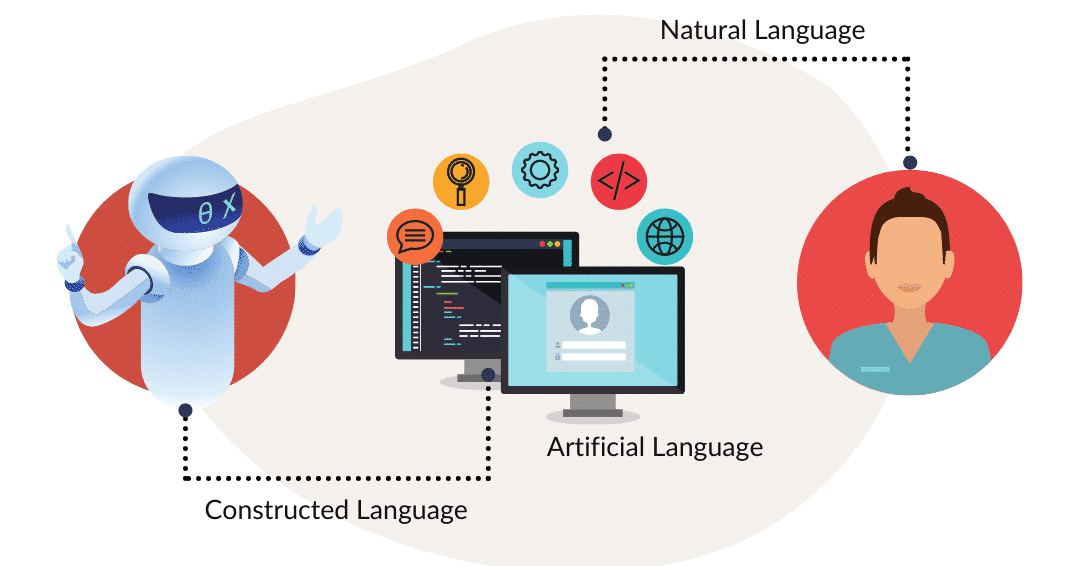There are thousands of different languages in this world. Have you ever thought about the difference between natural language, constructed language and artificial language?
Languages are like living creatures – they do not cease to evolve and change.
There are thousands of languages and dialects around the world. Some of them closely relate and belong to families such as the Indo-European languages or the sino-Tibetan language family.
Others are isolated in distant locations and are spoken by a few thousand, if not hundreds, speakers get doomed to die out.

In the meantime, new languages created by humans emerge. These languages may seem very similar to the language we as humans speak, but this is not really the case.
Indeed, man-made languages function differently, and oftentimes they use for communication between humans and machines. However, communication is not the only purpose they fulfil.
Has this sparked your curiosity? You are ready to dive deep into the topic of natural, artificial, and constructed languages.
Are you looking for language translation services?
Milestone helps you seamlessly translate content & localize your website, products, and services for more reach, better conversions, and greater sales.
What are natural languages?
Natural languages are all the languages that have evolved naturally through interaction and repetition without any conscious planning of their development.
For instance, English, Hindi, German, Chinese, Serbian, etc. are all-natural languages.
Latin can be regarded as a natural language as well; however, it is now dead which means they don’t speak anymore and thus, cannot evolve.
What’s important to understand about natural languages is that they do not have a creator.
Even if we trace it back to its roots, it would be virtually impossible to find a single person who invented the language. Natural languages do not have a single origin.

For instance, Bulgarian is an Eastern-European language and stems from the Proto-Slavic language.
Also Read: What Are The Most Spoken Languages in Eastern Europe?
Still, its vocabulary is not entirely Slavic.
Up to 30% of, the Bulgarian vocabulary gets composed of foreign words (e.g. from Turkish or Greek). Why? This could be due to historical and geographical factors.
For the most part natural languages evolve through usage. Words change their meanings, some words rise in popularity and after a few years completely disappear until they come back again with a completely different meaning.
Also Read: 10 Untranslatable Bulgarian Expressions
Natural languages influence each other
What’s more, natural languages influence each other. Nowadays English has left its mark on almost every living language.
In France, the French Academy publishes annually lists of approved French words in an attempt to limit the pervasive influence of English.
Natural languages change, grow and mutate through the interaction of speakers. These interactions sometimes result in the emergence of new languages.
Today’s linguists have established the notion of World Englishes. For example, in India, people mix local languages with English to form widely spoken hybrids like Hinglish and Kanglish.
Also Read: Hinglish- A Report on Usage and Popularity in India
Since English is so widely spoken, varieties have emerged and some of them might in the upcoming decades develop into distinct languages. They might die out as well, although this is extremely unlikely.
What is a constructed language?
The notion of constructed languages dates back to the 7th century’s Irish work Auraicept na n-Éces in which it was claimed that Old Gaelic, the predecessor of Irish, is a “selected language”.
Allegedly, Old Gaelic gotis not constructed created to eliminate the confusion of tongues (confusio linguarum) which resulted from the construction of the Tower of Babel as described in Genesis 11:1–94.

While the Irish language is a natural language and as such, it has no creator.
It is noteworthy that the concept of creating a constructed language to aid the communication between people with different mother tongues has existed for such a long time.
Today the language barrier is considerably reduced by the lingua franca of our modern times – English. Interestingly, the fastest growing language today, not constructed, but a natural one.
In general, we could say that a constructed languages were purposefully designed by humans.
Its phonology, grammar, and vocabulary are “constructed” to suit a specific purpose such as communication. It is based on existing natural languages, but not necessarily.
Morse code is a constructed language
Codes are constructed languages that aim to make communication faster and easier.
Take the Morse code which uses dots and dahs/ dashes to encode Latin letters and Arabic numerals as well as some punctuation characters.
There are no upper or lower cases. Information gets transmitted via light signals or sound waves.

As a constructed language the Morse code was invented to aid communication of confidential information. It has a specific way to transmit information (dots and dahs/ dashes) and each letter/ number is a particular sequence of dots and dahs.
This code was invented during the 19th century, however, it was a vital means of communication during WWII since it was fast, easy and the information remained secret.
Nowadays, you can study Morse code easily with the help of Morse code translator. These free online resources allow you to both convert text to Morse code and vice versa.
Other codes and cyphers used during WWII are the Pigpen cypher. For the purpose of this cypher one needs two grids with all the letters from the alphabet to create the key.
In this way, each character, represented by the “pigpen” by which it is surrounded.


What are controlled languages?
Another example of constructed languages is the so-called “controlled languages” and they are frequently used by translators when working with MT.
MT operates best when the source text is simple, direct, and literal.
To ensure better quality output, the source text might be pre-edited or “controlled” before it is run through the MT.
Pre-editing is a technique that ensures that the source text is less ambiguous and more straightforward. In this way, the MT system can produce more precise translations.
In other words, a controlled language, a simplified form of a natural language. Besides MT, such controlled languages, used for language learning.
Also Read: Machine Translation and Post Editing: Everything You Need to Know
For instance, we can adapt Macbeth by William Shakespeare for an intermediate English language learner.
Since they wouldn’t be able to understand most of the Modern English in which Shakespeare writes, we can use “controlled” English to translate the work with words that correspond to a particular language level.

What is Conlang?
Constructed languages are also called conlang.
In some cases, constructed, planned, artificial, and fictional languages get used interchangeably.
However, it would be more accurate to say that constructed language is an umbrella term for any human-devised language.
This means that planned and fictional languages are simply their sub-categories.
Check Out: GLOBAL LANGUAGE FACTS
Planned vs Fictional languages
Undoubtedly, both planned and fictional languages are “constructed” in the sense that they are created by a human for a specific purpose.
What’s more, they have not emerged through human interaction like natural languages. Still, these two terms denote two different sub-categories of constructed languages.
Are you looking for language translation services?
Milestone helps you seamlessly translate content & localize your website, products, and services for more reach, better conversions, and greater sales.
What are planned languages?
Planned languages are designed (or “planned”) for a specific purpose such as communication. For instance, an international auxiliary language (also called IAL or auxlang) is a planned language
Which has been developed for communication between people who do not share a common language.
A well-known auxiliary language is Esperanto. Some less known auxlangs are Ido and Interlingua.
Esperanto, in particular, was a planned language primarily built on European languages (but not solely). It was created with the sole purpose of international communication.
Programming languages also fall into the category of planned languages. They were created to help humans work with computers.

Also read: Emerging Trends in Translation Technology
What are fictional languages?
Fictional languages, on the other hand, have a very telling name.
Indeed, these languages are not real, but fictional and were developed to create a more realistic atmosphere in a book or a movie.
For instance, J. R. R. Tolkien created the Elvish languages Sindarin and Quenya (and many more) specifically for his books.
While fictional languages are not real, meaning they are “spoken” by fictional characters in books or movies, they are gaining more and more popularity.
As a result, many people are so passionate that they even try to learn these languages.
What are the most popular fictional languages?
According to Britannica the most popular fictional languages besides Elvish are:
- Alienese or the Alien language from the animated show Futurama was invented for hidden in-jokes on the show.
- Na’vi is a fictional language created by the linguist Paul Frommer exclusively for the 2009 blockbuster Avatar. Interestingly, fans have helped the linguist to continue developing the language.
- Dothraki was created by the Game of Thrones author George R.R. Martin. However, in his book the author included only very few words from the fictional language. Thus, the creators of the HBO series hired experts to develop it.
- Klingon was created by the linguist Marc Okrand for the TV show Star Trek. Okrand has even published books about it. There is a translation of Shakespeare’s tragedy Hamlet in Klingon.
What is an artificial language?
The concept of artificial languages is not as new as you might think.
Indeed, due to the decreasing popularity of Latin as early as the 17th century the first artificial languages were developed.
However, they aimed to “rationalize” the living languages by eliminating all the inconsistencies and creating clear categorization.
Today, artificial languages are primarily used in evolutionary linguistics. With the help of artificial languages researchers aim to investigate the dynamics of living languages and how they evolve.
A very important aspect of artificial languages is that their form depends on the experiment they are being created for.
This means that an artificial language could be a simplified form of a natural language or it could be a completely new language.
For instance, in his work Morten H. Christiansen1 “invented” an artificial language that used symbols such as ❂●■❂■ letters to investigate the word order evolution of languages.
In addition, as pointed out in Dr. Christine Cuskley’s paper2 on language evolution, when a researcher’s focus is on vocabulary, an artificial language with a limited vocabulary could be invented to suit the purpose of the experiment.
Artificial vs. Constructed languages
You might be confused as to how artificial and constructed languages are two different things. Indeed, these two terms are oftentimes used interchangeably.
While this has become acceptable even by linguists, there are some details you need to pay attention to understand the difference.
As you can see from the table above, the main aspect in which artificial and constructed languages differentiate is their purpose.
It is important to understand that artificial languages’ sole purpose is experimenting. They are highly prospective and have a very limited size.
Why?
Artificial languages are created for a specific experiment. For instance, if a researcher focuses on a particular grammar feature (e.g. cases or word order) the artificial language is developed for that purpose.
It won’t consist of millions of words because it will make the experiment harder.
Instead, it will have a rather limited vocabulary since the main focus of the experiment is grammar.
What’s more, since artificial languages are created with a specific experiment in mind, they have a very short-lived nature.
This means that they are rarely used after the particular experiment they were created for is finished.
Constructed languages, on the other hand, emerged as a result of humans’ desire to connect. They are an attempt to overcome the language barrier.
Constructed languages were developed before the rise of English as a lingua franca so that people with different first languages could communicate.
Are programming languages constructed languages?
All programming (e.g. Java, C++, Python) as well as markup languages (e.g. HTML, XML) are constructed languages and are used for communication between machines and humans.
While some languages are easier to learn, others are considered the hardest coding language by many.
A human enters a command via a code (this can be a sequence of characters or a single word). As a result, the machine completes the task and presents the results.

As the computational power of computers continues to increase, programming languages become more similar to natural languages.
However, programming and markup languages still have a very limited size and are prescriptive.
In a nutshell, artificial and constructed languages are very similar regarding their limited size and prescriptive, human-made nature.
However, artificial languages have a very precise purpose – experimenting (hence, their short life) while constructed languages are much more diverse and thus, has a much wider application.
Check Out: LANGUAGE INFOGRAPHIC GALLERY
Natural Language vs. Artificial language vs. Constructed language
Let’s revise the table above. Besides artificial and constructed languages we will add a new category – natural languages.
Natural languages cannot be prescribed, but rather described. We don’t use language based on some grammar rules – we simply use it.
Another very important difference is that natural languages have native speakers. Native means that a person has spoken a particular language since the day they were born or said their first word out loud.
What’s more, natural languages evolve on their own, so to say. They are not constructed by humans with a specific purpose.
While people do not determine how a language develops, it is the speakers and how they interact with each other that changes a natural language.
As you can see, humans “create” languages unintentionally while they communicate with each other. However, this change is not intended, but rather it mirrors the culture or the particular age.
A very suitable example would be Victorian English which is barely comprehensible by English speakers today.
During the Victorian age, English people had different beliefs and their language conformed to their culture.
As does English in our modern age. Nowadays, we use “influencers” and “social media” – concepts unknown to Victorian society.
All in all, natural languages are “free spirits”. They do not follow any prescriptions and cannot be intentionally changed by humans.
They simply are.
Natural languages are the way humans communicate with each other and somewhere along the way they evolve. Constructed and artificial languages are, in contrast, rather limited and not as free.
They follow clearly prescribed rules and change is nearly impossible unless a human decides to intentionally alter them.
The exploration of natural, constructed, and artificial languages opens the door to many fascinating areas of study and application.
It is particularly relevant in today’s digital era, where artificial languages are increasingly used in developing sophisticated technologies. Among these, Artificial Intelligence (AI) and Machine Learning (ML) stand out, given their ability to mimic human intelligence and learn from data patterns, respectively.
To build these intricate systems, there is a growing demand for expert guidance. Utilizing Machine learning development can be instrumental in harnessing the power of artificial languages.
These Company professionals have the specialized skills needed to craft AI and ML systems that can effectively interact with both constructed and natural languages, pushing the boundaries of technological innovation.
To conclude
Natural languages’ sole purpose is communication. We, humans, are social creatures and as such we use natural languages to establish contact with the people around us.
Our desire for communication and evolution was so strong that we have gone beyond natural languages and created our own languages that we now call “artificial” and “constructed”.
Are you looking for language translation services?
Milestone helps you seamlessly translate content & localize your website, products, and services for more reach, better conversions, and greater sales.






